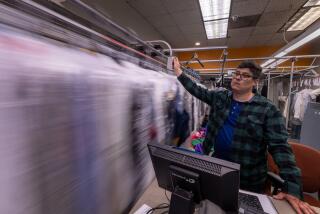Rub-a-Dub-Dub, Subway Trains Get a Good Scrub : Transportation: Figuring that the public won’t go for dirty cars, the RTD has devised an elaborate cleaning ritual.
Long after each sleek, $1.5-million, Italian-made Red Line car pulls in for the day, a 20-year-old Guatemalan immigrant named Nancy Corado is on her hands and knees performing a nightly ritual that is as crucial to the subway’s success as any high-tech gadgetry.
With a spray bottle of cleaning fluid dangling from her pants pocket, she grabs a thick brush and combs the dirt and crumbs off the red and black cushions on the car’s 59 seats. First the seat backs, then bottoms, scooping the dust onto the floor.
Then she fires a few squirts of soap into a clean white cloth--one of about two dozen that will be used during her shift. She rubs the towel back and forth to spread the cleanser around, then takes aim at the cream-colored plastic that covers the seats, walls and ceiling.
“Look at this,” Corado says, unfolding one of the cloths. “It’s so black.” Then she points to a gleaming seat frame she had been scouring. “Now look at this. That’s the color it’s supposed to be.”
When that is done, she rubs down the stainless steel doorways with lemon oil, while 35-year-old Jose Ramos expertly passes his squeegee over the tinted glass windows. Maria Estrella, 27, the mother of three little girls, readies a bucket of soapy water. After sweeping the length of the 75-foot train, they mop the simulated-marble linoleum until it shines.
“The truth is I like to clean,” says Corado, recalling her early years in Guatemala, where most young girls are expected to help with the household chores while their male counterparts are often allowed to play outside.
“I don’t know why. I guess I’m just good at it.”
Clean and safe . Safe and clean . These are the two words transit officials repeat more than any others when talking about the future of the Red Line.
If riders do not feel comfortable descending into the stations, rubbing shoulders on the platforms and packing into the 169-passenger cars, then the decade of planning, the $1.4 billion already spent, could all be for naught.
That is why RTD has declared a policy of zero-tolerance for graffiti and grime, devising an elaborate cleaning ritual to ensure that its 16 subway cars begin the day looking as spanking new as they can.
“I guarantee it,” said Dave Kalasnik, RTD’s manager for rail equipment maintenance. “I’ve made that commitment, and we will stand firm.”
The process begins with the last train of the day, which makes its way to the rail yard along Santa Fe Avenue about a quarter past seven.
The first stop is a specially designed carwash, housed in a corrugated fiberglass shack behind a thick iron fence topped with razor wire. The driver shifts into an automatic gear that sets the train at 3 m.p.h., then pushes a button activating the brushes and pumps.
A barrage of 72 high-pressure nozzles bathe the train in water. Another 40 nozzles douse it in an alkaline wash, which is changed to acid once a month to give extra gloss to the cars’ stainless steel finish. Four huge green brushes meet the train on both sides, while a big blue brush catches it from above. Then comes the rinse phase, with 144 more nozzles hosing off the soap.
From there, the train travels into a cavernous warehouse, illuminated in a fluorescent glow and engulfed in a high-pitched electronic buzz. Maintenance crews go through the cars, testing the doors, the lights, the alarms. Then, they climb into pits below, examining the underbelly, the brakes and the trueness of the wheels’ spin.
Corado’s three-person crew from Empire Maintenance Co., a private firm that contracts with RTD, comes on at 8 p.m. Every night, they spend about six hours cleaning just two cars--a thorough working over that supervisors refer to as the “major scrub.”
While they go over every nook and cranny, a second cleaning crew of six RTD employees dressed in orange safety vests comes on the job at 10:30 p.m. Their task is to give any other car in operation a quick scouring, which averages about 30 minutes a car.
Scuff marks and finger smudges are wiped out with squeeze bottles of Spartan Tough Duty Industrial Strength All Purpose Cleaner.
Seat cushions get treated with spray cans of Motsenbocker’s Lift-Off, a spot remover that can strip chewing gum, lipstick stains and candle wax--not to mention degrease an engine or carburetor.
Finally, for those really nasty spills, there is unopened bottle of NADBC, or Non-Acid Disinfectant Bathroom Cleaner, which purports to kill the HIV infection “on all inanimate surfaces.”
“Even though it’s a never-ending battle and the same routine over and over again, you still got to leave it looking nice for the public,” said Ken Gaines, 34, who spent more than two years cleaning Blue Line trains before switching to the Red Line last month.
For all the preparations, for all the arsenals of cleaning supplies, RTD officials have been amazed at just how spotless the first 200,000 riders have left the Red Line.
There have been only two reports of graffiti, scrawled on seat backs during the inaugural weekend. A quick scrub and it was gone.
There has been some gum, a candy wrapper, a rubber band and the usual assortment of dusty footprints, grease marks and stained cushions. But in a city awash in spray paint, trash-strewn streets and urine-soaked alleys, it seems as though its underground commuters have taken pride in their new ride.
At least Corado has. “When we finish,” she says, “it looks beautiful.”
More to Read
Sign up for Essential California
The most important California stories and recommendations in your inbox every morning.
You may occasionally receive promotional content from the Los Angeles Times.









